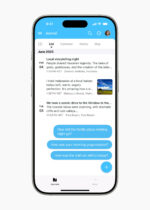Amid all the suspicions of what is going to be available to developers in iOS 5, there are a few confirmed additions that have developers buzzing. Among these are a new notification center, an over-the-air sync feature, and the ability to continue to create hybrid mobile/Web applications.
Other additions, according to the company, include Newsstand, iMessage, and new features in Safari, such as the Safari Reader.
“The new notification center is the most significant because it lets developers communicate with their users when the application isn’t open,” said Ryan Engle, senior iOS developer at Mutual Mobile.
Henry Balanon, cofounder and director of mobile at Detroit Labs, viewed the inclusion of automatic reference counting as the most significant new feature. “It is basically the convenience of garbage collection with the speed of using retain/release. Developers are used to explicitly doing retain/releases, and now we don’t have to do that,” he said.
Joe Pezzillo, cofounder of Push IO (a cloud service provider for mobile devices), said that he is impressed with the changes. He believed this shows that Apple is beginning to understand the pain points felt by developers, and it is interested in making significant changes to ease them.

“Apple is using their position to improve its platform for developers too, which most competitors don’t do,” he said. “Apple is providing better tools for the planning and development stage of the process.”
One such example is Joseph Lewis’ most awaited feature: location simulation. Lewis, chief Web architect at Sandia National Laboratories, explained that although location simulation is a simple addition, it’s a necessary one.
“We have a lot of location-aware app development going on, and it is going to be useful to have that instead of hard-coding location in,” he said.
iCloud also seems to be a favorite addition. According to several developers, it will significantly change how they create applications that go beyond the iOS device hardware.
“I’m interested to see how iCloud will sync information between devices; the information [available online] makes it seem like iCloud will just work, which is a scary concept for developers,” Engle said.
“Being able to synchronize data between multiple devices silently over the air is going to be so ridiculously cool in so many ways that none of us has even thought of yet,” said Jonathan Saggau, founder and CEO of Sound Broken, a Mac OS X and iPhone software contracting shop. “I’m constantly thinking of things I can do with iCloud, and I’m certain fellow developers feel the same. We are going to see a lot of innovation here, and it really will seem like magic at first.”
Beyond the notification center, the ability to perform updates in the back via the over-the-air updates seems to be something developers are excited about.
“Wireless sync will help developers, because right now many applications need an external management system,” said Engle. “If iCloud works, updates should happen for free, in the background.”
“I’m most excited about the over-the-air updates to iOS 5 and later,” said Balanon. “This will encourage more people to update to the latest version of the OS and we don’t have to support legacy OS versions for too long.”
The unknown factors of iOS 5 may perhaps be the most eagerly anticipated. Facial recognition is a feature many are talking about.
“Facial recognition [functionality] opens up doors in augmented reality applications. It is a big leap toward the future,” Engle said.
#!
But others wanted more
Beyond the additional capabilities, some developers are also disappointed by what Apple isn’t going to include in the iOS 5 release.
Balanon would have liked to see speech recognition included, although nothing has been formally announced yet. “There were whispers of collaborating with Nuance for speech recognition. I was hoping for speech input from the keyboard,” he said.
Saggau said “a real layout engine” would have been a great addition for the iOS 5 release. “Spring and Struts are nice, but it is actually kind of painful to get some basic things looking right [in iOS],” he said.
“Apple is noted for great design, but they really do not make it easy to position UI elements, and I’m also not a huge advocate for Web views in iOS applications, but sometimes this is necessary [to get the right look].”
Jonathan Blocksom, iOS developer and founder of GollyGee Software, is concerned about what’s really going to be available as he feels the documentation is “pretty weak.”
“I’m discovering a lot of things the hard way,” he explained.
Blocksom also would like a zoom button to be included as he said it can be hard to work with the new GUI elements on a small screen.
Sandia’s Lewis wants more access to native features, like the GPS and accelerometer. Native applications have the ability to take advantage of some of the features native to the iPhone hardware, which can sometimes affect the type of application developers choose to create.
#!
Native apps vs. mobile Web apps
Determining what type of application to develop for the iOS is also part of the discussion, particularly with the new in-app purchasing model imposed upon existing and new applications, and those that wish to be added to the App Store.
There are three kinds of applications developers can create for iOS and smartphones in general, according to Stewart Putney, CEO at Moblyng, a social game application development company. He said that developers can create a native Objective-C application, an HTML5-enhanced mobile site or an HTML5-enhanced mobile site wrapped in Objective-C code.
The native applications and the HTML5 hybrid apps are both sold through the App Store, and thus are subject to restrictions and the 70/30 revenue share.
“If you have a brand with users already, you might want to create a mobile browser application because you don’t need the App Store to promote your brand,” Putney said, adding that the App Store is still a great model for companies that need promotion, but he added that they should also look into alternative distribution channels.
Amazon, Facebook and others are looking to distribute applications built on HTML5 standards, which could mean additional distribution channels and revenue models. Putney said that creating a mobile-enhanced website would be ideal for this situation, and would still allow developers to capture iOS customers.
Creating mobile sites, such as m.Facebook.com, allow all mobile-phone users to view the site in the browser, although with limited functionality. This greatly reduces the costs associated with maintaining applications for multiple operating systems and hardware devices.
Additional updates in iOS 5 come with the tools and applications used to create native iOS applications. Apple has made some significant improvements to Xcode, its IDE for creating these applications.
“I used to work on the .NET applications and found them more mature and polished,” said Mutual Mobile’s Engle. “Now, Xcode has moved in that direction, where a few years ago it was a bit frustrating to work with.”
He also said that the newest version of the Xcode program is much more polished than in previous iterations as an indication of Apple’s current response to developer complaints.
Although Apple’s App Store approval process provides a certain guarantee of security for end users and application developers against malware and other security threats, threats are still a concern for developers.
“The big issue with security is that people store a tremendous amount of data on there,” said Push IO’s Pezzillo, adding that Apple is taking a strong stance for security with its app approval process, among other things.
“Ultimately what iCloud can provide to developers is to make things easier for developers to incorporate infrastructure in their applications,” he said. He explained that services could be created using iCloud servers, which give developers a lot more security than using a third-party server product or hosting them on company servers, which may not be able to provide the amount of support a native application needs in addition to all of the other functions it provides for a company.
Sandia’s Lewis said he is always concerned about security, but he is very interested in S/MIME for authentication and encryption in e-mail.
“I’m optimistic for the S/MIME feature, but worried that it might suffer usability or technical problems in the final mix. I’m concerned that device encryption may have flaws. I’m concerned for exploits yet to be discovered,” he said, although he explained that he believes these will be taken care of in the final release.





